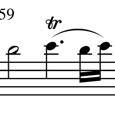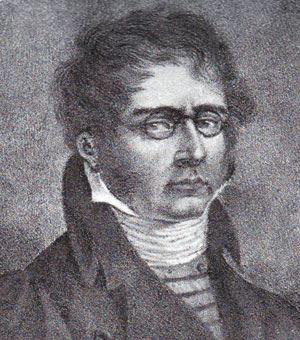 Franz Danzi was a prolific composer, conductor, and skilled cellist. Born in 1763 in Schwetzingen, Germany, he came from a notable musical family that included his father, Innocenzo, a highly regarded cellist who performed with the Mannheim Orchestra, his violinist brother Johann, and his sister, Franziska Lebrun, a well respected singer. Danzi studied cello with his father and assumed his father’s cello position in the Mannheim Orchestra in 1783. Danzi also studied composition with German composer and teacher Georg Joseph Vogler.
Franz Danzi was a prolific composer, conductor, and skilled cellist. Born in 1763 in Schwetzingen, Germany, he came from a notable musical family that included his father, Innocenzo, a highly regarded cellist who performed with the Mannheim Orchestra, his violinist brother Johann, and his sister, Franziska Lebrun, a well respected singer. Danzi studied cello with his father and assumed his father’s cello position in the Mannheim Orchestra in 1783. Danzi also studied composition with German composer and teacher Georg Joseph Vogler.
In 1790 Danzi married opera singer Maria Margarethe Marchand. She was a student of Leopold Mozart and a childhood friend of W.A. Mozart. Danzi conducted and his wife sang on tours throughout Prague, Hamburg, and Italy from 1791 until their return to Munich in 1798. He then accepted a conducting post in Stuttgart following his wife’s death in 1800. After leaving Stuttgart in 1812, he took a post as the orchestra director at the Karlsruhe Court Theater until his death in April 13, 1826. In addition to admiring the works of Mozart, Danzi had associations with several prominent German composers including Louis Spohr and Carl Maria von Weber.
Danzi is generally considered one of the last composers of the Mannheim School, but his writing also represents his role as a transitional composer from the late-Classical into the early-Romantic period. His diverse catalog of approximately 200 compositions includes vocal and choral, orchestral, stage, and chamber music. His chamber music literature includes wind quintets, a genre he is often credited with inventing, trios for flute and strings, sonatina for flute and piano, wind quintets with piano, and four flute concertos.
The Concerto #1 in G major, Op. 30 for flute and orchestra was composed around 1805, the same year as his D minor, Op. 31 flute concerto. He wrote two other flute concertos: Concerto #3 in D minor, Op. 42, and Concerto #4 in D major, Op. 43, both of which were composed in 1812.
Concerto #1 is an elegant and lively composition that provides a showcase for well developed technique and musical phrasing. Edited by Peter Anspacher, the 15-minute work is published as an arrangement for flute and piano by Heinrich-shofen. The edition doesn’t specify dynamics in the solo flute part, but the piano score has dynamics markings for the flutist to review with the accompanist. Advanced flutists looking for a musical challenge will enjoy presenting this lesser known, audience-pleasing concerto on a recital.
I. Allegro
The first movement is in cut time, and the flute takes center stage, executing demanding passages featuring wide intervals, and extensive 16th-note arpeggios and runs. Following a 58-measure introduction, the solo flute echoes the same theme presented in the accompaniment’s opening bars.

In measure 59, make a soloistic but not overpowering entrance, in keeping with the light chord texture in the accompaniment. It’s important to have accurate timing on the trilled C in the first measure so it doesn’t slow the tempo at the beginning. The first theme has a Mozart-like quality so play it in a light, clean style.
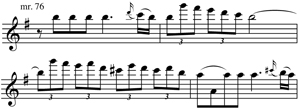
The next flute entrance in measure 76 occurs off the beat. Anticipate the entrance to avoid being late on the B and cleanly execute the D grace note before starting the triplet figure in measure 77. This section requires good flexibility to negotiate a series of triplets and scale passages that begin in measure 82 and continue to the high A in measure 90. Dedicating practice time at a slow tempo for the 16th-note runs and arpeggios will pay big dividends in this movement, and also for the third movement. Focus on checking for correct intonation and articulation accuracy while practicing the sixteenths quite slowly before speeding up to a performance tempo.
Danzi often uses a pause to set off a new theme. The fermata over the quarter note rest in measure 90 is an example of this. A brief one- or two-bar cadenza at the fermata on the second beat would be appropriate before beginning the second musical idea presented through bar 98.
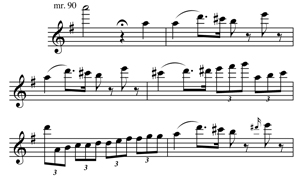
The secondary theme has the quality of an aria and should be played with a lyrical and expressive, but not overly dramatic, quality. Measure 99 begins a passage of 16ths that extend through measure 106. Practice this passage slowly to ensure that the rhythm remains consistent, the first note of each 16th-note grouping is clearly articulated, and the repetitive A-F#-A sixteenth-note pattern beginning in bar 99 is not rushed.
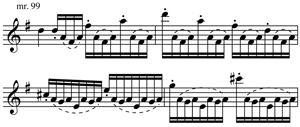
Maintain forward motion all the way to the G in measure 110. It would be beneficial to record your practice session for this section, as well as the other technical passages, to listen for evenness in tone and fingering transitions.
Bars 107-109 each begin with an octave drop from the first quarter to an arpeggio and scale run. Listen at the start of each measure to the accompaniment to fit the upper octave quarter note into the chord with correct intonation. The main theme returns briefly after the trill from E to F# in measure 18. The piano part sets up the next section providing an 11-measure rest until bar 137 for the flute. Watch intonation on the numerous C#s sprinkled throughout the next eight measures until measure 150. This section is somewhat exposed and there are numerous C#s in the piano part that should match with the flute pitch.
Pay careful attention to the accompaniment in measures 166-169. The piano has a 16th-note passage on the second beat while the flute rests in measure 166 and 169. The accompaniment then returns to the main theme during the eight-bar break in the solo flute at measure 190.
The rest of the movement playfully displays the flute’s technical capabilities with the flutist rapidly switching from double to triple tonguing during extended runs. It’s time to show off and have fun as the first movement comes to a close. A few measures of cadenza may be added at the fermata in bar 206 before the second theme returns in bar 207.
Danzi again prefaces the return of the second theme with a pause at bar 226. Consider using the B-flat trill key for the repetitive B to A# figure in bars 223-224 and 229-230. The trill fingering is a possibility for the tricky repetitive D to C# in measures 225-226 and 231-232. Start with the standard D above the staff to C# fingering for the first interval, and then switch to the trill fingering. Work with a tuner to bring the pitch in line with the standard fingering if you elect to use the trill fingering.
II. Larghetto
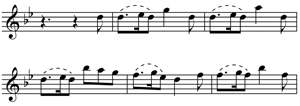
The second movement is typical of the Sicilianos found in Mozart concertos and sonatas. Its slow 68 meter in G minor is a pleasant contrast to the energetic first movement. In the orchestral version, the accompaniment is mostly strings with occasional wind entrances, so keep the character of the movement light and flowing. Rhythmic accuracy is essential in order to keep the eighth-note pick up to the dotted-eighth note rhythm consistent and not bog down the tempo from the flute entrance in measure 5 through measure 20.
The solo flute then winds through a passage of intervals and arpeggios until measure 36. Note the interesting 32nd-note figures in bars 28 and 30; they have an ornamental quality and the rhythm should not be rushed. There is a tendency to hurry down the chromatic scale starting at measure 37 that leads back into the main theme at measure 40, but this is a suitable place for a ritenuto before measure 40.
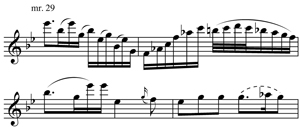
The second movement is attacca into the third movement so prepare for the final movement’s tempo while holding the fermata on the last note.
III. Allegretto moderato

The opening theme of this movement is deceptively simple, so take care with establishing the tempo and base it on the difficult passages that occur later in the movement, such as those beginning in measures 41, 74, and 192. In rondo form and 24 time, the movement requires a light tongue to maintain the sophisticated, elegant feel established in the earlier movements.
The extended passage from measure 30 through 47 poses a significant breathing challenge. Catch a quick breath after the A in measure 34. Some flutists may be able to last until the next obvious breath spot in measure 42. Most players will want to take a supplemental breath before that to ensure proper support on the high notes in measure 37 and the intervals from the high C#, A, and E to the low As in measure 40. One breath possibility is after the D#3 in measure 37. Carefully planned breaths are also required for measures 120 through 133. Consider a quick breath after the first eighth in measure 123 or possibly leaving out the first eighth note B because the piano also plays that note. Grab another quick breath after the high E in measure 131 to set up the chromatic run up to the E minor chord in measure 34.
The third movement is demanding and requires meticulous practice of the technical passages from measures 30 – 47, 64 – 82, 120 – 142, 152 – 164, and 192 to the end. Develop a practice plan in advance for these sections by breaking down the larger passages into smaller groups of measures, and identify duplicate or similar patterns, such as the E minor sections in 120-134 and 152-166.
The main theme returns in measure 91 and continues through measure 103. After the 8-bar accompaniment that starts in 112, Danzi brings his concerto to a flashy close with 121 measures of continuous virtuosity, including the coda at measure 192.
